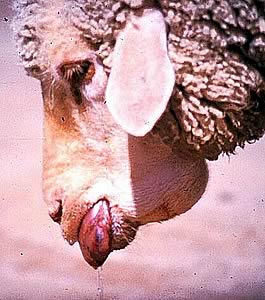 |
|||||||||
|
|||||||||||||||||||
|
|
Bluetongue virus in the Netherlands
identified as serotype 8 by IAH Scientists at the Institute for Animal Health's Pirbright Laboratory have shown that the bluetongue virus causing disease in the Netherlands is serotype 8. This serotype has not previously been identified in Europe.
The virus had been sent to IAH Pirbright by the European Commission, as IAH Pirbright is the European Community Reference Laboratory for bluetongue. After confirming that the disease in the Netherlands was bluetongue, the IAH Pirbright scientists worked day and night over the past week to identify the serotype of the virus. Having eliminated that possibility that the virus was one of the five serotypes previously detected in southern Europe (types 1, 2, 4, 9, and 16), they developed tests for the other 19 types. The identification of the serotype was done by PCR tests late on Friday night (25th August). The test involves the gene for protein VP2 of the virus. VP2 unequivocally specifies the serotype of the virus. The PCR result was confirmed by sequencing most of genome segment 2 of the virus, on Saturday (26thAugust). Professor Philip Mellor, Head of the European Community Reference Laboratory (CRL) for bluetongue said "The isolation of a bluetongue virus serotype new to the region, by Professor Peter Mertens' group at Pirbright, within only eight days of receipt of the first infected sheep material from the Netherlands, is an astonishing feat." This was achieved not only by round-the-clock working but also by the application of modern diagnostic tests that had been developed at Pirbright. These tests focussed on detecting and sequencing the genes of the bluetongue virus (BTV). This was much faster than the older methods used to identify previous BT outbreaks in southern Europe, which took three to four weeks. Typing of the virus is important in tracking where the BTV-8 virus came from. The results show that the Dutch isolate is NOT descended from vaccine forms of the bluetongue virus that have been used in many parts of southern Europe including Bulgaria, Italy, Corsica, Spain, and also in South Africa, in recent years. The gene sequence data points to an origin in sub-Saharan Africa. The initial infected sheep material was received from The Central Institute for Animal Disease Control, CIDC-Lelystad, Wageningen UR, The Netherlands.
|
||||||||||||||||||

|
|
||||||||||||||||||
| home | agri-services | pedigree
pen | news | dairy | beef | machinery quota | property | organisations | site map |
|||||||||||||||||||
